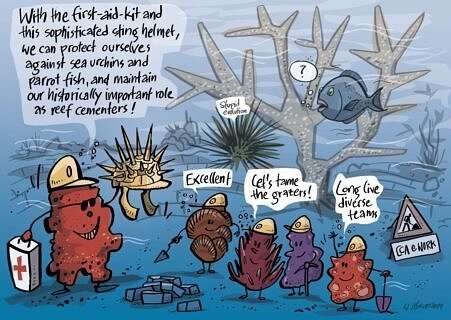The cement for coral reefs

Coral reefs are hotspots of biodiversity. As they can withstand heavy storms, they offer many species a safe home, and at the same time, they protect densely populated coastal regions as they level out storm-driven waves. However, how can these reefs that are made up of often very fragile coral be so stable? A team of researchers from Friedrich-Alexander Universität Erlangen-Nürnberg (FAU) and the University of Bayreuth have now discovered that a very specific type of 'cement' is responsible for this—by forming a hard calcareous skeleton, coralline red algae stabilize the reefs, and have been doing so for at least 150 million years.
The wide variety of life they support is immediately apparent on images of tropical coral reefs. Their three-dimensional scaffolding provides a habitat for a large number of species. However, the skeletons of the coral are often so fragile that they would not be able to withstand heavy storms by themselves. Even if scientists have long suspected that coralline red algae provide support to reefs with their calcareous skeletons, this is the first time that this link has been proven.
Coralline red algae have been supporting coral reefs for at least 150 million years
The researchers from FAU and the University of Bayreuth were able to prove this supporting function by analyzing more than 700 fossilized reefs from 150 million years of the Earth's history. "The coralline red algae form a calcareous skeleton and cement the coral reefs together," explains Dr. Sebastian Teichert from the Chair of Palaeoenvironmental Research at FAU. "However, several crises over the course of millions of years have limited their capacity to do so."
Successful adaptive strategies against plant grazers
These crises include the evolution of plant grazing marine animals such as sea urchins and parrot fishes who have repeatedly decimated populations of coralline red algae over the course of time. The algae, however, developed defense mechanisms such as special growth forms in order to defend themselves against their attackers. "The algae have adapted so well that they now even benefit from these plant grazers," says Teichert. "They rid the coralline red algae of damaging growth such as green algae, allowing it to grow unhindered." This means coralline red algae are more successful at supporting coral reefs today than ever before in the Earth's history.
The extent to which climate change affects the supporting role of coralline red algae is not yet known. Any deterioration to their living conditions would not only affect the coral and other inhabitants of reefs, but also humans, as coral reefs level out storm-driven waves and make an important contribution to coastal protection. They also provide a nursery habitat for several fish and shellfish which are an important source of food.
More information: Sebastian Teichert et al, A possible link between coral reef success, crustose coralline algae and the evolution of herbivory, Scientific Reports (2020). DOI: 10.1038/s41598-020-73900-9
Journal information: Scientific Reports
Provided by University of Erlangen-Nuremberg




















